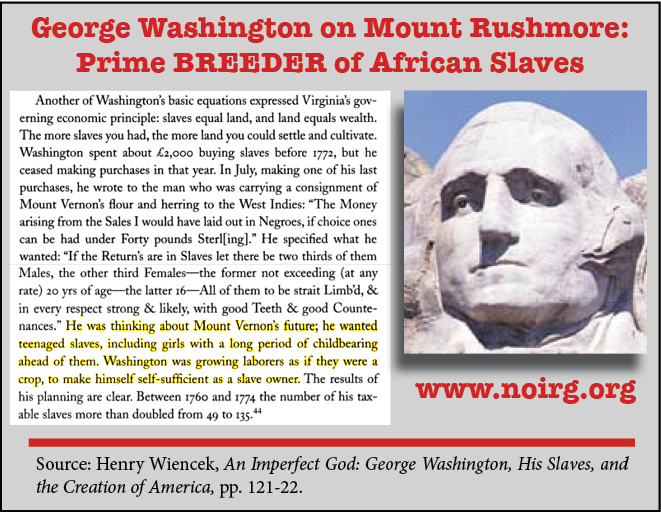George Washington’s Monument: Cracked from the Beginning?
The recent earthquake—centered in Washington, DC, at the very moment American and NATO oil thieves entered “the shores of Tripoli”—did major damage to the Washington Monument, the iconic symbol of America. But the very concept was flawed from the start: America’s father, George Washington (1732-1799), was one of the largest slave owners in American history.

He laid the corner stone of the Federal District in the name of Freemasonry, and grateful Americans erected a 555-foot monument in his honor. His home state of Virginia was the prime breeder of Black people for the domestic slave trade, and at one point the state exported 6,000 Black people annually—their biggest “cash crop.”
In 1786, Washington held 216 Black Africans—116 workers, 92 children and 8 sick or injured slaves (he had many more over the years). This unusually high number of children who were unable to work the plantation indicates that George was heavily involved in the breeding of Black people for the slave trade. Washington gave them such names as:
Breechy
Suck
Lame Alice
Virgin
Jupiter
Dorcas
Winny
Sucky
Flukey
Hercules
Giles
Paris-boy
Doll
Cook Jack
Sambo
Opey
Suck Bass
House Sall
Caesar
Cupid
Though he often expressed what he called a “repugnance” toward the institution of slavery, Washington recognized that the very country he founded was based entirely upon the free labor of the Black race:
• He accepted slaves as payments for debts, and bought them as needed; he proposed to exchange slaves for land.
• A visitor to his plantation called Washington’s slave cages “more miserable” than the worst of Europe.
• He opposed the use of slaves as soldiers in the American Revolution because he thought (rightly) that armed Blacks might see the colonists as their mortal enemies. Indeed, at least 17 of Washington’s own Black captives escaped to join the British in 1781.
• He avoided speaking publicly about the issue of slavery, seemingly at all costs.
• He carefully made sure that the slaves he brought with him to the presidential office (then in Pennsylvania) would not use the state’s abolition laws to free themselves from slavery.
• When one slave absconded in 1795, Washington told his overseer to take measures to apprehend the slave, “but I would not have my name appear in any advertisement, or other measure, leading to it.”
Black women captives of Washington were subject to the sexual predations of those who visited the first president—and to the predations of George himself. Indeed, George has been linked to the rape of his female slaves, producing presidential offspring that predated even Thomas Jefferson’s. One of George’s guests seemed downright indignant: “[W]ill you believe it,” he wrote in 1784, “I have not humped a single mulatto since I am here.”
Most despicable of all, both George and Thomas put the full force of the new United States government behind the French attempt to repress the rebellion of Black Africans in the colony of Haiti. Washington, in fact, said he would be “happy” to help his white counterparts in destroying the rebellion. Only over his dead body did Washington “free” his 317 Black human beings (the number he owned had doubled since his American Revolution in 1776)—his will “emancipated” the Blacks on his Virginia plantation.
In his lifetime Washington proved too cowardly to deal with the rank hypocrisy of America’s enslavement of an entire race of people and feared, as he had written to a friend in 1794, that “I shall be happily mistaken if [slaves] are not found to be a very troublesome species of property ere many years pass over our heads.”
